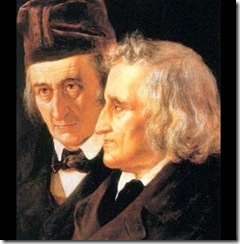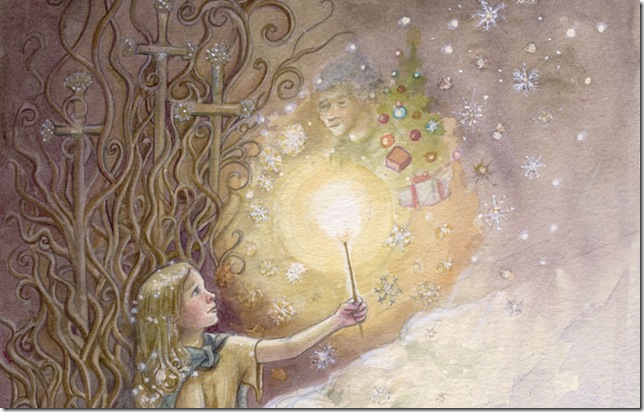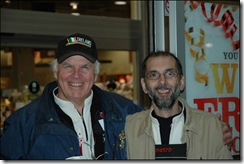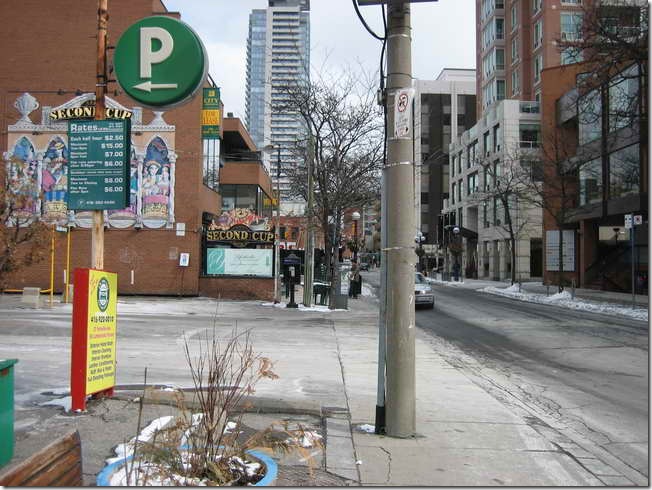Twenty years ago, I made a series of radio shows on creativity in the arts. In the course of doing so, I interviewed actor and playwright Alan Williams. He was a tall lanky bloke with longish unruly red hair and piercing blue eyes who was born, raised and professionally trained in Manchester. His broad accent and absurd, self-effacing humour made him a pleasure to speak with. I became aware of his work when I attended three one-man shows that he had written and performed. The Cockroach Trilogy, as it was called, had played to packed houses all across Canada and critics and audiences agreed that this was wildly original, entertaining and extremely absorbing theater. I was keen to learn from Williams how he managed to write the way he did. He made certain observations that stayed with me and since I kept the original taped interview I am going to quote from it. 
“When I’m writing a play, I know I have an idea that will work if I can conceive of a situation in which conflict is bound to result which can be resolved . A good play involves people with something at stake having to make swift decisions in order to try and get what they want. Since this is the situation we are always in, we have a strong feeling of sympathy with the characters because we can see that they’re in the same stupid mess that we are – wanting something and being faced with a world that doesn’t particularly want to give it to them and having to decide on the spot how to get what they want….. At one point when I was travelling around, I went through a fairly rootless, actually homeless period !! I was trying to write plays and one of the things I would take with me wherever I went was a collection of Grimm’s fairy stories because they seemed to me to be a tremendous kind of guide to how to write. There is a sense to Grimm’s fairy stories that everything which happens is real. One of the biggest problems with writing is to try to work out when a conflict is actually real, when there is really something at stake, when something new is actually happening.”
My first encounter with writing was a fairy tale. I cannot tell you which one. When my brother and I were infants, my grandmother gave us two thick volumes of fairy tales. She bought them at an auction sale and I imagine they were printed in the 1920’s if not earlier . Both were bound in cloth hard cover and had full page colour illustrations on glossy paper – each a work of art in its own right. The cover of the one containing tales of the brothers Grimm was brown and the other with the stories of Hans Christian Andersen was a burnt orange . I recall my mother reading these to me before I could read them myself. She claimed to have started reading to us well before we could walk or talk probably to put us to sleep. As a young child of 3 or 4 I can remember starting to understand what was being read to me and being much more frightened of the ‘orange’ stories as I thought of them, than the ‘brown’ ones which seemed simpler and friendlier. I also thought the former were much scarier in a grown up kind of way as if they were really stories for adults that were read to children as a special privilege like being allowed to stay up late to watch The Twilight Zone.
I can remember thinking that fairy tales were real. I believed they were actual accounts of events that had occurred at some point in the past and could happen again especially if magical and immortal beings were involved. Even if the magical beings were destroyed at the end, who could say that there were not others of their kind hanging out somewhere? This was both frightening and reassuring depending on the character. Who wouldn’t like to encounter the fairy godmother or the white rabbit in the vest?? I’m sure there are millions like me. I think part of this has to do with the fact that stories conveyed through the voice of an adult or the printed page have a certain degree of authority and credibility to the mind of a child. Before a certain age it seems that the line between what is possible and impossible has not been firmly etched. Above all I believe that children would not experience a fairy tales in this way were not the writing superb. By far the longest story in the orange book was The Snow Queen written in 1845.
It is actually comprised of seven stories. I don’t think it was ever read to me probably because it was so long and the words were pretty difficult for my mother whose first language was not English. As a result, the story took on a sort of forbidden quality as if the content were just too grown- up for children. When I was finally old enough to be able to read it for myself, I was haunted by it because I thought it had been written about two children very similar to me and my brother . Here is how it begins.
Story the First, Which Describes a Looking-Glass and the Broken Fragments.
YOU must attend to the commencement of this story, for when we get to the end we shall know more than we do now about a very wicked hobgoblin; he was one of the very worst, for he was a real demon.  One day, when he was in a merry mood, he made a looking-glass which had the power of making everything good or beautiful that was reflected in it almost shrink to nothing, while everything that was worthless and bad looked increased in size and worse than ever. The most lovely landscapes appeared like boiled spinach, and the people became hideous, and looked as if they stood on their heads and had no bodies. Their countenances were so distorted that no one could recognize them, and even one freckle on the face appeared to spread over the whole of the nose and mouth. ….All who went to the demon’s school—for he kept a school—talked everywhere of the wonders they had seen, and declared that people could now, for the first time, see what the world and mankind were really like. They carried the glass about everywhere, till at last there was not a land nor a people who had not been looked at through this distorted mirror. They wanted even to fly with it up to heaven to see the angels, but the higher they flew the more slippery the glass became, and they could scarcely hold it, till at last it slipped from their hands, fell to the earth, and was broken into millions of pieces. But now the looking-glass caused more unhappiness than ever, for some of the fragments were not so large as a grain of sand, and they flew about the world into every country. When one of these tiny atoms flew into a person’s eye, it stuck there unknown to him, and from that moment he saw everything through a distorted medium, or could see only the worst side of what he looked at, for even the smallest fragment retained the same power which had belonged to the whole mirror. Some few persons even got a fragment of the looking-glass in their hearts, and this was very terrible, for their hearts became cold like a lump of ice….. . There were still a number of these little fragments of glass floating about in the air, and now you shall hear what happened with one of them.
One day, when he was in a merry mood, he made a looking-glass which had the power of making everything good or beautiful that was reflected in it almost shrink to nothing, while everything that was worthless and bad looked increased in size and worse than ever. The most lovely landscapes appeared like boiled spinach, and the people became hideous, and looked as if they stood on their heads and had no bodies. Their countenances were so distorted that no one could recognize them, and even one freckle on the face appeared to spread over the whole of the nose and mouth. ….All who went to the demon’s school—for he kept a school—talked everywhere of the wonders they had seen, and declared that people could now, for the first time, see what the world and mankind were really like. They carried the glass about everywhere, till at last there was not a land nor a people who had not been looked at through this distorted mirror. They wanted even to fly with it up to heaven to see the angels, but the higher they flew the more slippery the glass became, and they could scarcely hold it, till at last it slipped from their hands, fell to the earth, and was broken into millions of pieces. But now the looking-glass caused more unhappiness than ever, for some of the fragments were not so large as a grain of sand, and they flew about the world into every country. When one of these tiny atoms flew into a person’s eye, it stuck there unknown to him, and from that moment he saw everything through a distorted medium, or could see only the worst side of what he looked at, for even the smallest fragment retained the same power which had belonged to the whole mirror. Some few persons even got a fragment of the looking-glass in their hearts, and this was very terrible, for their hearts became cold like a lump of ice….. . There were still a number of these little fragments of glass floating about in the air, and now you shall hear what happened with one of them.
I believed that The Snow Queen was a real story that had been recorded by Andersen as a special message to me and other little girls in my situation.. It is the story of Gerda and Kay a little girl and boy who are best friends. One day a piece of the evil mirror fell into Kay’s eye and another into his heart so that it became a lump of ice. He changed from a warm and loving friend to an arrogant cruel boy who rejected Gerda. One day while playing on his sledge with the others boys, he is captured by the Snow Queen and taken to her palace near the north pole. Of course nobody knows what has happen to him and after months pass, all believe he is dead – all except Gerda. She is able to ask flowers, birds and other animals what became of him and slowly she is led on a quest to find him travelling hundreds of miles enduring all manner of hardships such as freezing cold, hunger, various forms of evil enchantment, robbery, and kidnapping. Finally she is in the hut of the “Finland woman” who is asked by a reindeer if she cannot give Gerda something to help her battle the Snow Queen.
“I can give her no greater power than she has already,” said the woman; “ don’t you see how strong that is? How men and animals are obliged to serve her, and how well she has got through the world, barefooted as she is. She cannot receive any power from me greater than she now has, which consists in her own purity and innocence of heart.”
I was born three years after my brother and he did not appreciate this occurrence one little bit. Although I desperately wanted his love and companionship he rejected me in every way he could (and has admitted this as an adult) He was often nasty and physically violent frequently making me cry. I found great comfort when I read The Snow Queen, since it seemed to contain some kind of explanation as to why he was the way he was- that his meanness to me and many others was a result of some kind of spell he was under and that someday I would be able to reverse it and return him to the way he really was. I was also consoled by the possibility that I had the same basic innocence and purity of heart as the heroine and therefore I had the power to do so.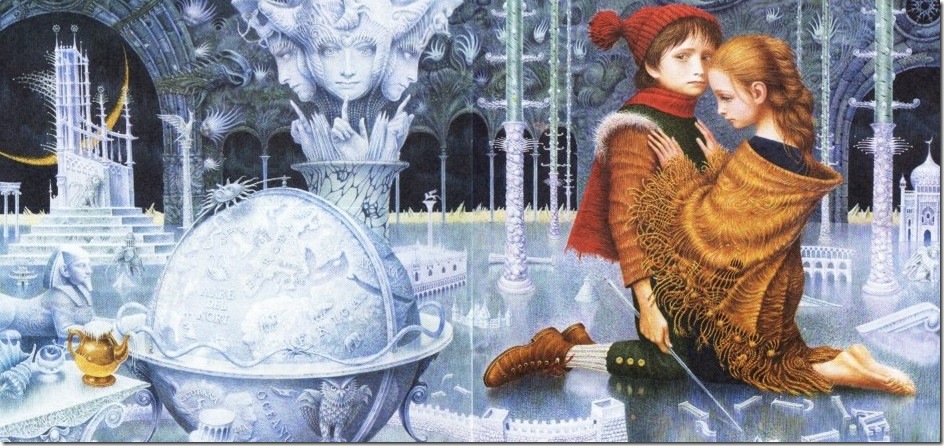
The Snow Queen was my story. If I felt bullied The Ugly Duckling was my story. I went to The Nightingale if I felt undervalued. If I felt trapped I went to Alice in Wonderland or The Twelve Dancing Princesses. When I felt greedy my story was The Fisherman and His Wife and when my family didn’t love me enough my story was Babar or Curious George. I have always had a hard time knowing what I feel and fairy tales seemed to give form to my emotions and even explain where they came from. They also offered solutions to terrible problems. I could walk through a mirror, drink a magic potion, get advice from a tiger lily, spin straw into gold or summon the good witch of the north. The extreme unlikelihood of these possibilities never seemed to detract from the comfort and hope that they gave me.
I wonder how many children are able to endure the fear, sadness and loneliness of their childhood through fairy tales. I think this is only possible because great children’s literature carries them to these depths before the pain is resolved.
In her essay, Hans Christian Andersen, Father of the modern Fairy Tale, Terry Windling observes that “what many readers remember most about Andersen’s work is its overwhelming sadness. The Little Match Girl dies; the Little Mermaid is betrayed by her prince, the Fir Tree lies discarded after Christmas, sighing over past glories. Even tales that end happily — The Snow Queen, the Ugly Duckling, Thumbelina, the Wild Swans — are heart-wrenching in their depiction of anguish endured along the way.”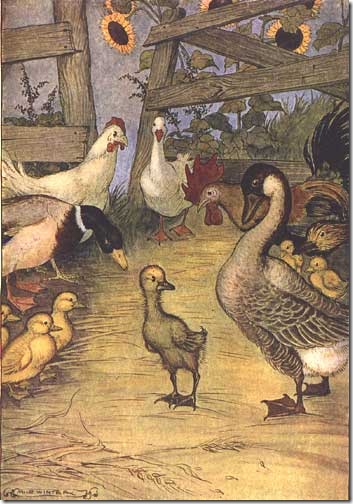
After reading all this, you might be surprised (or perhaps horrified) to learn that from time to time I work as a therapist. I have had years of conventional university training in my profession and I work with adults . People usually seek therapy when they are unhappy but often are confused about the specifics : what they do feel and why they feel it. Therapy is a tough process. It requires a great deal of courage to confront emotions that have been suppressed or buried particularly if we see them as unattractive or shameful. . Even after many sessions a client may not yet be ready to delve into certain areas but they can often take in a similar story about someone else. Sometimes a real example quickly comes to mind but more often than not a fairy tale says it better. I guess when you are exposed to something over and over again from a young age it is never that far away from your consciousness and is easy to reach for.
Of course I wouldn’t say “I knew this rabbi years ago called Rumpelstiltskin ,although that was his name before he changed it.” or “Have I ever told you about my cousin Rapunzel ?” What I might tell them is that their situation reminds me of someone and I would not be lying. What does it matter that they remind me of a mermaid or a wooden boy as long as I can convey that they possess the same degree of courage, goodness, and strength of character that is needed to overcome their adversity. Fairy tales are considered great writing because the conflicts are utterly convincing and are often resolved through the development or complete metamorphosis of character. Elves and magic rings and ruby shoes and snow queens are simply catalysts for change. A person in therapy needs to know that transformation is possible for them and when they can’t imagine it for themselves the therapist may have to imagine it for them.
If you happen to be in the business, I can recommend some reading….

